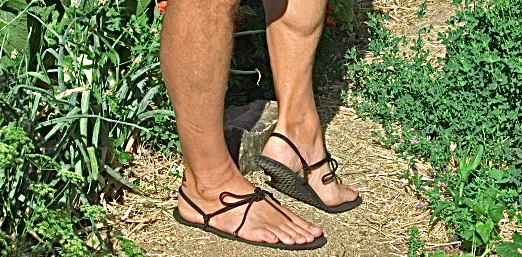
I don’t like writing shoe reviews, because I don’t like many shoes. People often ask what I wear, and in the Barefoot section of my website, one could see some of these shoes. The fact is, most of the day, Coralee and I are usually barefoot. There are times when we do put something on our feet—playing a music gig, going into town, traveling, or when hiking and running on the trails we often wear something that’s minimal. Coralee has stuck with her Vibrams ever since first wearing them—the transition was overnight (see her review of them here).
I love huaraches, but through the years rarely have found a pair that won’t bother me even for walking, let alone running. You see, I’m easily overloaded with sensory stimulation. Most shoes and sandals I’ve tried on immediately are annoying to my feet and brain. Throughout my career I’ve had many companies give me various foot products. Such was the case with a relatively new sandal I recently received. The company is Invisible Shoes and they refer to them as a “modern take on huaraches.”
This sandal is a fine fit to the simple yet exotic life—the totally holistic, minimalist world Coralee and I have created here in the southern Arizona mountains, one that yields the maximum amount of fun. We wear the least amount of clothing, are barefoot most times (and often bare-bodied), use the smallest amount of daily energy, plant the minimum amount of food for our year-round needs, and are as close to being off the grid without overspending on solar scams or being hermits. Whatever footwear we use is the bare minimum, and zero drop for sure.
The Invisible Shoe is nothing like flip-flops, which are spongy, too thick and flop each time you step (and one could never run in them without risking injury). In fact, like ill-fitting shoes, you have to use more muscle action to keep them from falling off your foot—that unhealthy physical effort can contribute to injury.
The only problem with Invisible Shoes—for me, at least—is that they require some assembly. They come simply as a sole with laces. But it has instructions. I’m not much for instructions, and long ago I learned not to do things I’m not good at. Luckily, Coralee, who is an M.D., is good with instructions, and at following them. Her simple surgical skills came in handy after watching the online video. Weaving the laces through the sole and around my foot appeared easy for her. I tried not to watch. In a very short time my huaraches were ready to wear.
I slipped them on—easy enough. I walked, jumped, and ran. It was an all around pleasant surprise. I actually liked them. They didn’t flop or fit weird, didn’t induce sensory overload, and I could use them in all terrains—smooth, sand, rocks and road. Despite the very thin sole, they appeared quite immune to sharp rocks and thick thorns common here in the high lush desert.
I hadn’t run in sandals in years, maybe decades, and would not run a long distance right away until getting used to them, especially the lace going between the first and second toe, which doesn’t seem to be taking much time even for me. But 20 minutes was enough to tell me these will work for running.
The Invisible Shoes come in two rubber tread thicknesses. The 4 mm “Connect” is closest to barefoot, and very lightweight. The 6 mm “Contact” has a bit more protection, stiffer, and both are very flexible.
While today’s shoe companies can’t help overcharging even for simple footwear, Invisible Shoes range from about $13 to $25 for kits (kids to adults), and about $40 for a custom-made pair. You can get the standard shoe kit for $19.95. They even have online videos to show you how to assemble them. Of course, I didn’t watch any of them, but you might want to.
